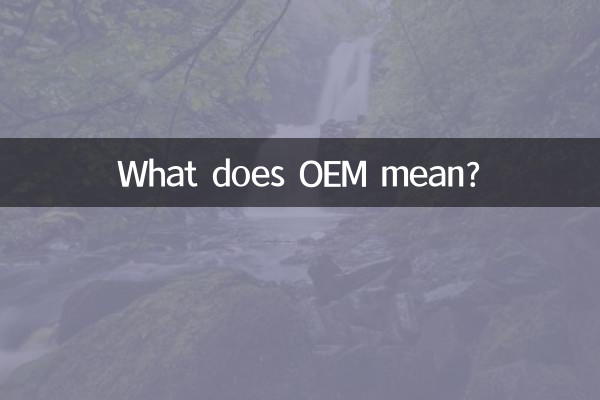What does OEM mean?
In recent years, with the rapid development of manufacturing industry, the term "contract processing" has frequently appeared in various industries. So, what exactly does OEM mean? What are its features and advantages? This article will combine the hot topics and hot content on the Internet in the past 10 days to provide you with a detailed analysis of the meaning, types and application scenarios of OEM.
1. Definition of OEM

OEM, also known as "OEM" or "OEM (Original Equipment Manufacturer)", refers to a cooperation model in which the brand entrusts a third-party manufacturer to produce products according to its requirements, and the brand is responsible for sales and promotion. The core of OEM processing is "entrusted production". Brands can quickly launch products without building their own factories.
2. Types of OEM processing
Depending on the cooperation model, contract processing can be divided into the following types:
| Type | Features | Applicable industries |
|---|---|---|
| OEM (Own Label Production) | The brand provides the design and the foundry is responsible for production. | Electronic products, home appliances, clothing |
| ODM (Original Design) | The foundry provides design and production, and the brand directly OEMs | Cosmetics, food, daily necessities |
| EMS (Electronic Manufacturing Services) | The foundry provides full-process services, including design, production, and testing. | Semiconductors, communication equipment |
3. Advantages of OEM processing
The contract processing model is very popular around the world, mainly due to the following advantages:
1.Reduce costs: Brands do not need to invest a lot of money to build factories and only need to pay OEM fees, which greatly reduces production costs.
2.Respond quickly to the market: Foundries usually have mature production lines and technologies and can quickly produce products that meet market demand.
3.Focus on core business: Brand owners can focus on product design, brand promotion and sales without being distracted by the production process.
4.High flexibility: OEM processing can flexibly adjust the production scale according to order volume to avoid the risk of inventory backlog.
4. Industry applications of OEM processing
The OEM model is widely used in many industries. The following are the popular OEM industries and their characteristics in recent years:
| Industry | OEM content | Popular products |
|---|---|---|
| food and beverage | OEM production of snacks, drinks and health products | Meal replacement shakes, functional drinks |
| Cosmetics | OEM production of skin care products and makeup | Facial mask, lipstick |
| electronic products | OEM production of mobile phone accessories and smart devices | TWS earphones, smart watches |
5. Precautions for OEM processing
Although the OEM model has obvious advantages, you still need to pay attention to the following points when choosing an OEM:
1.Factory qualification: Ensure that the foundry has relevant production qualifications and certifications to avoid product quality problems.
2.Contract terms: Clarify the responsibilities of both parties, including delivery time, quality standards, payment methods, etc.
3.Sample test: Before mass production, be sure to ask the foundry to provide samples for testing.
4.After-sales service: Understand the after-sales service capabilities of the foundry to ensure that product problems can be solved in a timely manner.
6. Future trends of contract processing
With the deep integration of the global industrial chain, the OEM model will continue to develop. In the future, the contract processing industry may show the following trends:
1.Intelligent production: Foundries will introduce more automation equipment and AI technology to improve production efficiency.
2.Customized services: As brands’ demand for personalized products increases, foundries will provide more flexible customization services.
3.green manufacturing: Environmental protection requirements are becoming increasingly strict, and foundries will pay more attention to sustainable production.
In summary, contract processing is an efficient business model that can help brands quickly implement products. Whether you are a start-up or a mature brand, you can reduce costs and improve competitiveness through the OEM model. If you are considering OEM cooperation, be sure to choose a reliable OEM and conduct preliminary research and communication.

check the details

check the details